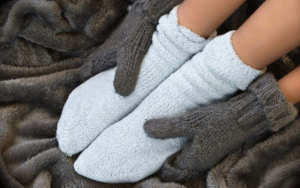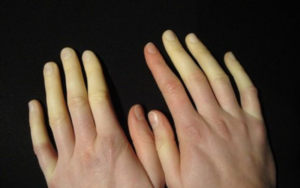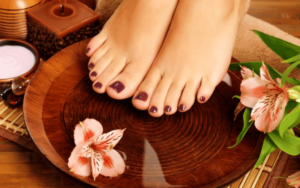Hands and feet are susceptible to cold in a low-temperature environment is a natural response of the body. However, there are cases where the hands and feet are constantly cold even when not in a low temperature environment, causing the skin color to change. That is a sign of cold hands and feet. So what exactly is this situation? Let’s learn more about Hylar in the following article!
What are cold hands and feet?
Hands and feet are part of the peripheral part of the body, often having a lower temperature than other parts. Therefore, in cold weather, the hands and feet are the most susceptible to cold on the body. Specifically, when the outdoor temperature drops, the body makes sure to keep the blood circulating to all the vital organs to stay warm. This can reduce blood flow to the extremities and make you feel cold. And this is completely normal. Because the blood vessels in the arms and legs now begin to constrict to avoid heat loss.

However, the limbs are constantly cold in normal weather or even in summer. Along with the change in skin pigmentation, this is a sign of cold hands and feet. For this condition, it is not subjective but must quickly find the cause of the disease.
What causes cold hands and feet?
What causes cold hands and feet?
- Arterial disease: When the arteries in the body are narrowed or dysfunctional, the blood flow to the arms and legs is reduced. This will lead to cold hands and feet.
- Diabetes: Poor circulation and circulation is a typical symptom in people with diabetes. However, if this symptom occurs in the hands and feet, it will make the limbs easy to get cold.
- Anaemia: a condition in which there is a decrease in the number of healthy red blood cells in the blood and the main cause of anaemia is iron deficiency. Red blood cells need iron to carry oxygen from the lungs to the rest of the body. But with low iron levels, red blood cells will not have enough haemoglobin. As a result, hands and feet are susceptible to cold.
- Hypothyroidism: An underactive thyroid gland that does not produce enough hormones to keep certain organs in the body working properly. And cold limbs is also one of the symptoms of hypothyroidism.
- Chickpeas (Raynaud’s syndrome): is a condition in which the fingers and toes and other parts of the body feel cold.
- Vitamin B12 deficiency: Vitamin B12 works to maintain the health of red blood cells. A lack of vitamin B12 can lead to a number of neurological symptoms. This includes feeling cold in the limbs.
In addition, menstrual pain in women is also one of the causes of cold hands and feet.
Consequences of prolonged cold hands and feet
Many people think that cold hands and feet are just a normal response of the body, but they do not know this is a medical condition. So they just warm up the body in the simplest and most common ways. However, prolonging the situation will leave some consequences later. So what are the consequences?

When you feel your hands and feet are cold and numb, there is no feeling. By habit, you will quickly warm the cold part with warm water. However, when you change the temperature suddenly like that, it will most likely cause pain and in a few days will be red and swollen. In addition, the injury caused by cold soaking in the damaged areas will be red. Then it continues to turn purple and swell.
If you still don’t find a way to treat it, it will gradually leave worse consequences. At this point, it is likely that the site will continue to redden and have blisters. It can even lead to skin breakdown and liquefaction.
What should be done to limit cold hands and feet?
Keep the body warm: the first way to effectively limit cold hands and feet is to keep the body warm. You need to pay special attention to keeping your limbs warm and especially your feet. It is recommended to use soft socks with good heat retention. As well as being able to absorb sweat effectively.
Herbal Salt Foot Soak: This is one of the fastest ways to warm up your feet. A reasonable time to soak your feet in a warm bath is from 10 to 15 minutes. Perform a daily foot bath before going to bed, not only helps to warm the feet but also helps blood circulation better.
- Daily physical activity: is the easiest way to warm up the body effectively. In addition, exercise also helps blood circulation to the limbs. And that helps keep your hands and feet warm throughout the day.
- Use a heating bag: for those who suffer from constant cold hands and feet, this is the most convenient way. Can be used anytime and anywhere.
- Eat right: eat foods that are high in calories and fat. Because these are foods that provide the body with a lot of energy to help warm the body.
- Supplement with B vitamins, vitamin C, vitamin E and amino acids: these are vitamins and minerals that help increase the amount of red blood cells in the blood. As well as strengthen the body’s resistance.

Epilogue
Hylar hopes that the article will help you better understand what cold hands and feet are. And if you experience prolonged cold hands and feet, go to the hospital immediately for advice on the best treatment method!
